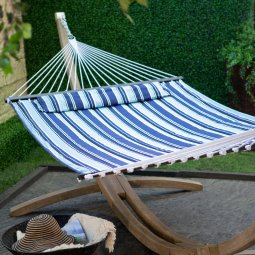A well-loved, broken-in hammock is a comfortable old friend
A fresh, new hammock is a beautiful thing to behold, but you'll discover a blizzard of "aaahs" as your hammock softens over time and shapes to your ways, making it truly yours. Follow these simple care and cleaning tips, and you'll get extra years, and the best naps, out of your hammock.

The new care-free materials
Good news for hammocks: newly developed fabrics improve resistance to sun and water, without sacrificing comfort. They last longer. Hammocks made of DuraCord stretch less than cotton, hold their color better, and resist sun damage, lasting twice as long as other materials. Olefin hammocks are so water-resistant that they don't mildew, and they dry quickly, even wicking moisture away from you. Olefin is also lighter, so you'll expend even less energy rocking back and forth. We offer hammocks made from Sunbrella too, a new woven material that's a favorite of outdoor furniture makers, and even for harsh marine applications, because it holds up so well against sun, rain, and children. Go ahead, spill that lemonade. It won't hurt.
Washing your hammock
Occasional washing helps any kind of hammock, considering dirt and dust grind down fabrics over time.
To machine wash your hammock, fold it in half so the ring ends meet, and tie the ends together with a cord. Tie up the other end, and fold once more in the middle. Put the bundle in a pillowcase and tie that up too. All this will prevent the hammock from tangling up in the wash. Use a mild detergent. Never use bleach, which deteriorates the cloth and strips helpful coatings from the fibers. Go ahead and use a little conditioner, which will help your hammock stay soft and smell good. Skip the dryer: it's best to air-dry your hammock. Just hang it back on it's frame or from you favorite tree. Don't store it wet, because mildew kills cotton.
Hand washing is even gentler. Tie your hammock as described above to keep it from getting tangled. Fill a large sink or bathtub with room-temp water and add a little mild detergent. Again, no bleach. Agitate it gently with your hands until you feel it is clean. A little softener is nice when you rinse it, to keep it soft and fresh. Wring it gently, untie it, and hang it out to air-dry. Done!





